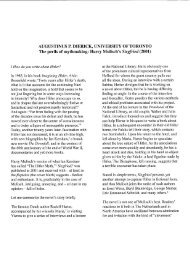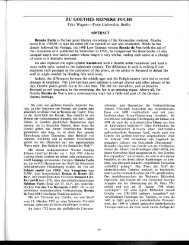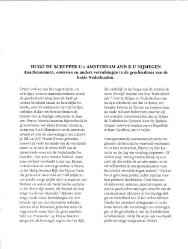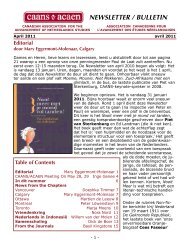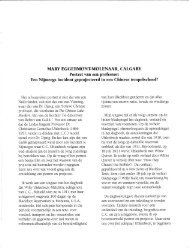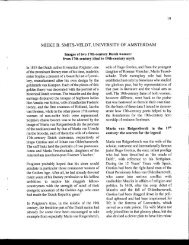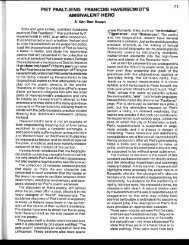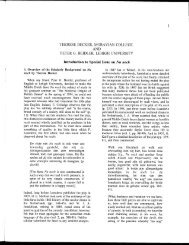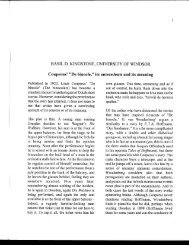BEERT VERSTRAETE - The Ring inside the Fish - canadian ...
BEERT VERSTRAETE - The Ring inside the Fish - canadian ...
BEERT VERSTRAETE - The Ring inside the Fish - canadian ...
Create successful ePaper yourself
Turn your PDF publications into a flip-book with our unique Google optimized e-Paper software.
14<br />
<strong>BEERT</strong> <strong>VERSTRAETE</strong>, ACADIA UNIVERSITY<br />
<strong>The</strong> <strong>Ring</strong> <strong>inside</strong> <strong>the</strong> <strong>Fish</strong>: A Comparison of <strong>the</strong> Use of a Similar<br />
Folklore Motif in Herodotus and a Dutch-Frisian Folktale l<br />
One of <strong>the</strong> best known Dutch folktales, "Het<br />
Vrouwtje van Stavoren," (<strong>The</strong> Lady ofStavoren),<br />
which is of Frisian origin, features a striking<br />
folklore motif: in a fit of fury and spite, after she<br />
has just committed an act of outrage which would<br />
seem to invite divine retribution, she takes a<br />
precious ring from her fingers and hurls it into <strong>the</strong><br />
sea with <strong>the</strong> defiant cry that it is as likely that she<br />
will be punished by being reduced to poverty as<br />
that this ring will be returned to her - and <strong>the</strong> ring,<br />
of course, does return. As a classicist, I am<br />
reminded of <strong>the</strong> story of <strong>the</strong> ring of Polycrates as<br />
told by <strong>the</strong> fifth century B.C. Greek historian<br />
Herodotus (3 .40-43). This paper wishes to explore<br />
<strong>the</strong> basic similarities, but even more <strong>the</strong> telling<br />
contrasts, in <strong>the</strong> use made of this colourful<br />
folklore motif in <strong>the</strong> two stories.<br />
Sith Thompson's multi-volume Motif-Index of<br />
Folklore Literature shows that <strong>the</strong> tale of a lost or<br />
cast-away valuable ring which is returned to its<br />
owner from <strong>the</strong> belly of a caught fish is<br />
recognized as an au<strong>the</strong>ntic folklore motif that<br />
turns up in a wide variety of cultures} One can<br />
readily see why such a remarkable event,<br />
spectacularly defying <strong>the</strong> odds, but still not<br />
entirely outside <strong>the</strong> realm of <strong>the</strong> possible, would<br />
appeal to <strong>the</strong> folk imagination. A ring is typically<br />
a prized object, and in myth, legend, and folktale<br />
often invested with magical and numinous<br />
powers; in <strong>the</strong> classical tradition, <strong>the</strong> story of <strong>the</strong><br />
ring of Gyges - in Plato's Republic (2 259c-260b)<br />
- which bestowed invisibility on Gyges and<br />
enabled him to seduce <strong>the</strong> king's wife, slay <strong>the</strong><br />
king, and seize <strong>the</strong> kingdom of Lydia for himself,<br />
comes immediately to mind. <strong>The</strong> return of a<br />
prized ring in such a virtually miraculous way<br />
would be readily interpreted as betokening a<br />
dramatic tum of ei<strong>the</strong>r good or bad fortune - good<br />
or bad depending on <strong>the</strong> full context in which <strong>the</strong><br />
event occurs; and so this motif could be used for<br />
a great diversity of narrative and moral-didactic<br />
purposes.<br />
This diversity is well illustrated by <strong>the</strong> use made<br />
of <strong>the</strong> motif in <strong>the</strong> Sanskrit play by Kalidasa,<br />
Shakuntala, dating perhaps from <strong>the</strong> fourth<br />
century. Here <strong>the</strong> miraculously returned ring<br />
portends a happy ending. Shakuntala is justly<br />
admired for its exquisite poetic style, which is<br />
well conveyed by <strong>the</strong> translation of Michael<br />
Coulson in <strong>the</strong> Penguin Classics series. 3 It was<br />
warmly received in <strong>the</strong> West after it had been<br />
translated into <strong>the</strong> principal Western European<br />
languages in <strong>the</strong> late eighteenth and early<br />
nineteenth centuries; indeed, it inspired Goe<strong>the</strong><br />
with <strong>the</strong> idea of a prologue consisting of a<br />
dialogue among <strong>the</strong> director, poet-dramatist, and<br />
a clown at <strong>the</strong> beginning of his Faust.<br />
In <strong>the</strong> Shakuntala, <strong>the</strong> motif is used in a<br />
straightforward fashion leading up to a happinessfilled<br />
denouement. <strong>The</strong> king falls passionately in<br />
love with <strong>the</strong> young woman Shakuntala, and she<br />
becomes pregnant by him. However, after she<br />
accidentally loses a ring that had been a present to<br />
her from her lover, he fails to recognize and<br />
acknowledge her, and she leaves his presence<br />
rejected and humiliated. This unfortunate tum of<br />
events is due to a curse placed on Shakuntala by<br />
<strong>the</strong> sage and ascetic Durvasas, who had felt<br />
slighted by <strong>the</strong> young woman - although <strong>the</strong><br />
slight had been unintentional and had amounted<br />
only to an absent-mindedness on her part;<br />
Durvasas had said that <strong>the</strong> king would fail to<br />
recognize and acknowledge her, and that this
<strong>The</strong> <strong>Ring</strong> <strong>inside</strong> <strong>the</strong> <strong>Fish</strong>: A Comparison of <strong>the</strong> USe ofa Similar Folklore Motif in Herodotus... 15<br />
curse would be lifted only if he saw some<br />
ornament given by him to her as a keepsake. <strong>The</strong><br />
story ends happily. <strong>The</strong> ring turns up <strong>inside</strong> a fish<br />
caught by a fisherman and is brought to <strong>the</strong> palace<br />
and <strong>the</strong> king, whose lapse of memory <strong>the</strong>n<br />
vanishes. He becomes remorseful and conducts a<br />
long and far-flung search for Shakuntala,<br />
eventually to be reunited with her and <strong>the</strong>ir young<br />
son - whom <strong>the</strong> king in fact encounters first and<br />
feels intuitively drawn to.<br />
In Herodotus' story and <strong>the</strong> folktale of<strong>the</strong> Lady of<br />
Stavoren, by contrast, <strong>the</strong> ring is cast away<br />
deliberately and its return portends disaster for <strong>the</strong><br />
protagonist. However, <strong>the</strong> two stories differ<br />
strikingly in <strong>the</strong> moral-didactic use <strong>the</strong>y make of<br />
<strong>the</strong> folklore motif. <strong>The</strong> tale of <strong>the</strong> ring of<br />
Polycrates is that of a man's ineluctable fate, in<br />
which divine retribution for wrongdoing plays no<br />
significant role; <strong>the</strong> story of <strong>the</strong> Lady of Stavoren<br />
is a morality tale on a grand scale, and <strong>the</strong> use<br />
made of <strong>the</strong> motif is made to conform to this<br />
intent.<br />
As Sir John Myers has pointed out,4 moira (fate)<br />
in <strong>the</strong> sense of an inescapable end assigned to a<br />
mortal by <strong>the</strong> personified moirai (fates) is<br />
attached only to four individuals in Herodotus:<br />
Croesus, Cyrus, Arcesiiaus, and Polycrates. (<strong>The</strong><br />
scope of this paper does not permit me to go into<br />
<strong>the</strong> complex question offate in Herodotus; suffice<br />
it to say that, while I do not think we can set aside<br />
<strong>the</strong> concept of an inescapable fate, I am attracted<br />
to John Gould's insight that Herodotus is not<br />
operating with a <strong>the</strong>ory of historical necessity, but<br />
is ra<strong>the</strong>r making use of "<strong>the</strong> traditional language<br />
of a teller of tales whose tale is structured by his<br />
awareness of <strong>the</strong> shape it must have and who<br />
presents human experience on <strong>the</strong> model of <strong>the</strong><br />
narrative pattems that are built into his stories; <strong>the</strong><br />
narrative impulse itself, <strong>the</strong> impulse towards<br />
'closure' and <strong>the</strong> sense ofan ending, is retrojected<br />
to become an 'explanation.",)5<br />
Much is made by Herodotus of <strong>the</strong> spectacular<br />
successes and prosperity of <strong>the</strong> sixth century B.C.<br />
tyrant and thalassocrat of Samos. But <strong>the</strong><br />
unbroken succession of Poly crates ' good fortunes<br />
has a sinister, fateful quality to it, recognized by<br />
<strong>the</strong> king of Egypt, Amasis, who writes Polycrates<br />
a letter of warning and advice (3.40): "It is<br />
pleasant to hear of <strong>the</strong> good fortune of a friend<br />
and ally; but your successes do not reassure me,<br />
for I know that heaven is jealous. I desire for<br />
myself and my friends that some affairs may go<br />
well and o<strong>the</strong>rs ill and our lives be not uniformly<br />
fortunate. For I have never yet heard of a man<br />
whose constant good fortune did not lead in <strong>the</strong><br />
end to misery and ,9iln. ,,6<br />
/<br />
He <strong>the</strong>n goes on to advise Polycrates to break this<br />
ill-omened unbroken chain of good fortune by<br />
casting away what is most precious to him and<br />
hardest to part with. Polycrates follows this<br />
advice: he boards a ship and sails far into <strong>the</strong> sea<br />
and <strong>the</strong>re he casts into <strong>the</strong> water his precious seal<br />
ring, an emerald set in gold. One might view this<br />
deed as an act of what I would call selfimmunization<br />
magic: by breaking <strong>the</strong> abnormally<br />
uninterrupted chain of good fortune and by thus<br />
restoring some human normalcy to his life and<br />
. appeasing <strong>the</strong> jealousy of <strong>the</strong> gods, Polycrates<br />
seeks to avert <strong>the</strong> catastrophe that will o<strong>the</strong>rwise<br />
eventually overwhelm him. 7 Such had indeed been<br />
<strong>the</strong> thrust of Amasis' advice. Polycrates' act of<br />
self-protection is, of course, to no avail. Five or<br />
six days later, a big, fine fish is cut open in <strong>the</strong><br />
kitchen and <strong>the</strong> ring is revealed. Herodotus relates<br />
that Polycrates took <strong>the</strong> return stoically,<br />
"perceiving a divine hand in <strong>the</strong> event" (3.42).<br />
Although <strong>the</strong> king of Egypt had advised him in his<br />
letter to repeat <strong>the</strong> act if his first effort failed, he<br />
makes no attempt to do so, but simply writes to<br />
Amasis what has happened. Amasis' reaction is<br />
that Polycrates' situation is indeed hopeless -<br />
because of <strong>the</strong> sheer unnatural quality of his luck,<br />
whereby "he was so lucky that he could not throw<br />
away a thing without its coming back to him"<br />
(3.43). In <strong>the</strong> end, Polycrates is lured to a cruel<br />
and ignominious death by <strong>the</strong> Persian satrap<br />
Oroetes (3.122-125).<br />
Herodotus tells this tale soberly without any high<br />
dramatization or moralizing. Polycrates, although<br />
spectacularly ambitious and ruthless enough if<br />
need be, is not portrayed as an especially evil<br />
man; and <strong>the</strong> archaic Greek understanding of <strong>the</strong><br />
jealousy of <strong>the</strong> gods overshadows any idea of
16 <strong>The</strong> Canadian Journal ofNe<strong>the</strong>rlandic Studies<br />
divine retribution for wrongdoing. 8 <strong>The</strong> story of<br />
<strong>the</strong> Lady of Stavoren is, by contrast, a morality<br />
tale, <strong>the</strong> story of an outrage committed that stems<br />
from a haughty and pitiless disposition and that is<br />
terribly but justly punished. <strong>The</strong> principal (and<br />
most elaborate) literary version I have read is in<br />
<strong>the</strong> collection of Dutch folktales, S. Franke's<br />
Sagen en Legenden rond de Zuiderzee, published<br />
in 1932.9 <strong>The</strong>re are o<strong>the</strong>r literary versions as well,<br />
<strong>the</strong> earliest one I have been able to locate being in<br />
a book on Frisian folklore and folk customs<br />
published in 1895 or 1896. 10 Despite Franke's use<br />
of <strong>the</strong> terms "sagas" and "legends," <strong>the</strong> large<br />
majority of <strong>the</strong> stories and anecdotes in his<br />
collection are best classified as folktales.<br />
As <strong>the</strong> author explains in his preface to what is<br />
obviously meant as a book for <strong>the</strong> general reader,<br />
it was his concern to collect and retell in a literary<br />
version a representative selection from <strong>the</strong> rich<br />
store of folktales, many of <strong>the</strong>m still circulating in<br />
oral form, originating in <strong>the</strong> coastal regions of <strong>the</strong><br />
former Zuiderzee, a horseshoe-shaped slice of <strong>The</strong><br />
Ne<strong>the</strong>rlands distinguished for its many<br />
picturesque fishing villages and historic towns,<br />
many of which had enjoyed <strong>the</strong>ir glory days of<br />
commercial vitality and economic prosperity in<br />
<strong>the</strong> distant past. This was a region of <strong>The</strong><br />
Ne<strong>the</strong>rlands also notable for its rich folk traditions<br />
as reflected in <strong>the</strong> tales collected and retold by<br />
Franke, and with <strong>the</strong> massive physical,<br />
environmental, and socio-economic changes<br />
slated for this region as a result of <strong>the</strong> damming<br />
off of <strong>the</strong> Zuiderzee, its conversion into a<br />
freshwater lake, and <strong>the</strong> massive polder<br />
reclamation projects, <strong>the</strong>se traditions were<br />
doomed to disappear - a true enough prophecy.<br />
Franke retells two versions of <strong>the</strong> story. I have<br />
chosen and concentrated on <strong>the</strong> more eventful and<br />
dramatic version, which is also <strong>the</strong> more popular<br />
oneY <strong>The</strong> story has become part of national<br />
Dutch folklore, and in 1969 a statue of <strong>the</strong> Lady<br />
was erected in <strong>the</strong> old harbour of <strong>the</strong> town, not too<br />
far from what is now a busy yacht haven. <strong>The</strong><br />
statue shows <strong>the</strong> Lady in fifteenth-century<br />
costume, peering into <strong>the</strong> distance and eagerly<br />
waiting for her ship, with its expected priceless<br />
cargo, to return.<br />
<strong>The</strong> story is of a fabulously wealthy merchant<br />
woman - a widow actually - in Stavoren, which<br />
once upon a time was a prosperous port and<br />
commercial centre. <strong>The</strong> Lady has become<br />
arrogant in her extreme wealth, despising <strong>the</strong><br />
poor, whom she blames for <strong>the</strong>ir condition. She<br />
conceives <strong>the</strong> desire to acquire a treasure so<br />
uniquely valuable and precious that it will inflame<br />
<strong>the</strong> envy of her wealthiest fellow citizens, and so<br />
she sends off one of ~er skippers on a mission to<br />
scour <strong>the</strong> earth for it' and to bring it back to her.<br />
<strong>The</strong> captain starts his long and seemingly futile<br />
search, at a loss as to what might satisfy <strong>the</strong><br />
inordinately ambitious cravings of his mistress.<br />
Finally, in a distant port, looking through a<br />
warehouse, he comes across a bale of wheat, and<br />
an inspired thought to him: is not this golden<br />
coloured grain, from which our daily bread is<br />
baked, <strong>the</strong> most beautiful and precious treasure<br />
imaginable? So he loads up his ship and sails back<br />
to Stavoren. His mistress is not pleased; she feels<br />
publicly humiliated as <strong>the</strong> skipper reveals his<br />
cargo. Furiously, she orders all of it to be dumped<br />
overboard into <strong>the</strong> water. <strong>The</strong> captain protests: <strong>the</strong><br />
poor can be fed with <strong>the</strong> precious food, and she<br />
risks punishment for <strong>the</strong> terrible sin of spiteful<br />
waste she is about to commit - punishment,<br />
perhaps, in <strong>the</strong> form of extreme poverty in which<br />
she herselfwill have to beg for a small measure of<br />
grain. This warning leads <strong>the</strong> Lady to a new<br />
outburst of fury, spite, and defiance:<br />
'''Me poor?' She laughed scornfully and<br />
straightway pulled from her finger a<br />
precious ring and threw it as far as she<br />
could into <strong>the</strong> sea, and cried out: 'As<br />
surely as this ring will never return to me,<br />
so sure it is I can never become poor.' ,,12<br />
Years later <strong>the</strong> ring returns via a caught fish, and<br />
<strong>the</strong>n disaster begins to strike: one by one <strong>the</strong><br />
lady's fleets are shipwrecked and her warehouses<br />
burned down, and in eventually she is reduced to<br />
abject poverty, forced to beg for her daily bread.<br />
<strong>The</strong> moral of this folktale is so obvious it does not<br />
have to be spelled out. But <strong>the</strong> folk imagination,<br />
as recorded by Franke, has projected <strong>the</strong> lesson<br />
this story carries onto an even larger screen. Not
<strong>The</strong> <strong>Ring</strong> <strong>inside</strong> <strong>the</strong> <strong>Fish</strong>: A Comparison of <strong>the</strong> Use ofa Similar Folklore Motif in Herodotus... 17<br />
only is <strong>the</strong> Lady of Stavoren punished and ruined,<br />
but <strong>the</strong> whole town, so arrogant in its prosperity<br />
and wealth, slips into decline as trading routes<br />
shift and <strong>the</strong> port is less and less frequented by<br />
ships and merchants. <strong>The</strong> folk imagination sees<br />
retribution exacted also through nature and<br />
constructs a vivid aetiology: <strong>the</strong> cargo dumped<br />
overboard becomes a large sandbar (called "Het<br />
Vrouwezand" - "<strong>The</strong> Lady's Sandbar"), which<br />
renders <strong>the</strong> harbour increasingly useless. Thus<br />
was explained <strong>the</strong> process of <strong>the</strong> silting of<br />
Stavoren's harbour over <strong>the</strong> centuriesY Finally,<br />
for good measure, <strong>the</strong> great floods that<br />
"swallowed up" <strong>the</strong> old town are also seen as an<br />
act of divine punishment. 14<br />
This Dutch-Frisian folktale looks back to <strong>the</strong><br />
glory days of <strong>the</strong> ancient town in <strong>the</strong> later Middle<br />
Ages (hence <strong>the</strong> fifteenth-century costume and<br />
headgear of <strong>the</strong> Lady of <strong>the</strong> statue earlier<br />
mentioned) when it was a prosperous port and<br />
member of <strong>the</strong> <strong>the</strong>n powerful Hanseatic League. IS<br />
By <strong>the</strong> sixteenth century, however, Stavoren was<br />
in serious decline, and by <strong>the</strong> Early Modem<br />
Period, <strong>the</strong> seventeenth and eighteenth centuries,<br />
it was only a shadow of its former self.<br />
Although <strong>the</strong> tales of Polycrates and <strong>the</strong> Lady of<br />
Stavoren both feature a protagonist who falls<br />
catastrophically from <strong>the</strong> heights of power and<br />
prosperity, <strong>the</strong> folklore motif of <strong>the</strong> cast-away and<br />
<strong>the</strong>n returned ring is put to conspicuously<br />
different narrative and moral-didactic use.<br />
Herodotus' story of Polycrates, including and<br />
especially <strong>the</strong> event with <strong>the</strong> ring, illustrates <strong>the</strong><br />
archaic Greek conception of <strong>the</strong> jealousy of <strong>the</strong><br />
gods and <strong>the</strong> ineluctability ofa person's fate if <strong>the</strong><br />
divine powers will it to be so. Polycrates' casting<br />
away of his cherished ring can be best viewed as<br />
an act of self-immunization magic calculated to<br />
break <strong>the</strong> sinister succession of good fortune that<br />
must ultimately and inevitably lead to catastrophe.<br />
<strong>The</strong> magical element in Polycrates' act of casting<br />
away his ring is underlined by <strong>the</strong> extreme<br />
measure he takes by sailing far out into <strong>the</strong> sea in<br />
order to make it as unlikely as possible that his<br />
ring will ever be recovered; in <strong>the</strong> Dutch-Frisian<br />
folktale, this deliberate precaution is absent - <strong>the</strong><br />
Lady of Stavoren simply acts impulsively as she<br />
flings <strong>the</strong> ring into <strong>the</strong> water.<br />
<strong>The</strong> story of <strong>the</strong> Lady of Stavoren is a morality<br />
tale on a grand scale, to which <strong>the</strong> folk<br />
imagination has added a notable aetiological<br />
component. This folktale must have originated in<br />
<strong>the</strong> period of decline of Stavoren, perhaps during<br />
<strong>the</strong> Early Modem Period, when <strong>the</strong> decline was<br />
complete, and <strong>the</strong> tiJlle was ripe for <strong>the</strong> folk<br />
imagination to devi~6 a tale of high drama which<br />
would explain <strong>the</strong>/decline as what one might term<br />
"a terrible but just punishment for <strong>the</strong> abuse of<br />
wealth and power." <strong>The</strong> fact that <strong>the</strong> protagonist<br />
is a woman is in keeping with socio-economic<br />
conditions of Western Europe during <strong>the</strong> late<br />
Middle Ages and into <strong>the</strong> Early Modem Period,<br />
when women, especially in <strong>the</strong> Low Countries,<br />
possessed a relatively high socio-economic status<br />
and power that was largely non-existent for <strong>the</strong>ir<br />
counterparts in <strong>the</strong> archaic and classical Greek<br />
world l6 - although I would suggest that casting a<br />
woman in <strong>the</strong> central role of <strong>the</strong> folktale betrays<br />
some misogyny as well. In any case, this is a<br />
larger-than-life morality tale, quite different in<br />
intent and tenor from Herodotus' story of<br />
Polycrates and his fateful ring.<br />
NOTES<br />
1 Earlier versions of this paper were presented at <strong>the</strong><br />
annual meeting of <strong>the</strong> Atlantic Classical Association in<br />
1996 and that of <strong>the</strong> Canadian Association for <strong>the</strong><br />
Advancement ofNe<strong>the</strong>rlandic Studies in 1997.<br />
2 Sith Thompson (editor), Motif-Index of Folk<br />
Literature, revised and enlarged edition, Bloomington<br />
and London: Indiana University Press, 1966: volume 1,<br />
p. 451, entry B548.2.1; volume 5, p. 22, entry L412.1;<br />
volume 5, p. 87, entry N211.1; for <strong>the</strong> more general<br />
ring motif, see volume 6, pp. 650-651, entry "<strong>Ring</strong>."<br />
3 Three Sanskrit Plays, translated and introduced by<br />
Michael Coulson, London, New York, etc.: Penguin<br />
Books, 1981.<br />
4 John L. Myers, Herodotus: Fa<strong>the</strong>r of History,<br />
Chicago: Henry Regner Company, 1971 (Oxford<br />
University Press, 1953),48.<br />
5 John Gould, Herodotus, New York: St. Martin's<br />
Press, 1989,77-78.
18 <strong>The</strong> Canadian Journal ofNe<strong>the</strong>rlandic Studies<br />
6 <strong>The</strong> translation of Herodotus used is that of Harry<br />
Carter, <strong>The</strong> Histories of Herodotus of Halicarnassus,<br />
London: Oxford University Press, 1962.<br />
7 With regard to <strong>the</strong> magical element in Polycrates' act,<br />
I am not really convinced by <strong>the</strong> explanation offered by<br />
Seth Benardete, Herodotean Inquiries, <strong>The</strong> Hague:<br />
Martinus Nijhoff, 1969, p. 82, namely that by casting<br />
away his priceless ring, Polycrates tried to "transfer" its<br />
"power" of enduring art to himself, while at <strong>the</strong> same<br />
time "propitiating divine jealousy." <strong>The</strong> magic falls<br />
under <strong>the</strong> wider catagory of apotropaic-sacrificial<br />
magic and ritual, most recently discussed - from a<br />
sociobiological perspective - by Walter Burkert, <strong>The</strong><br />
Creation of <strong>the</strong> Sacred: Tracks of Biology in Early<br />
Religions, Cambridge, Mass. and London: Harvard<br />
University Press, 1996, ch. 2, "Escape and Offerings."<br />
In ch. 6, "<strong>The</strong> Reciprocity of Giving," p. 146, Burkert<br />
makes brief mention of Poly crates' casting away of his<br />
ring, but this act cannot be properly understood, at least<br />
not in any primary sense, as presenting a gift to <strong>the</strong><br />
gods. I hope that my metaphorical term, "selfimmunization<br />
magic," catches more precisely<br />
Polycrates' intent.<br />
8 On <strong>the</strong> jealousy of <strong>the</strong> gods in archaic Greek thought,<br />
see A.W.H. Adkins, Moral Values and Political<br />
Behaviour in Ancient Greece, New York: W.W. Norton<br />
& Company, 1972, 78-82; also his Merit and<br />
Responsibility: A Study in Greek Values, Oxford:<br />
Clarendon Press, 1960.<br />
9 S. Franke, Sagen en Legenden rond de Zuiderzee,<br />
Zutphen: W.J. Thieme & Cie, 1932.<br />
\0 Waling Dijkstra, Vit Friesland's Volksleven van<br />
Vroeger en Later, part one, Leeuwarden: Hugo<br />
Suringar, n.d. but probably 1895-96, 46-47; in his<br />
preface (p. viii), Franke mentions this work as one of<br />
his literary sources for his collection. In <strong>the</strong> literature<br />
that I was sent by <strong>the</strong> V.V.V. (Tourism Office) of<br />
Friesland in <strong>the</strong> summer of 1996 were included two<br />
retellings of <strong>the</strong> story in contemporary Dutch verse.<br />
11 Franke, "Het Vrouwezand," 292-301; <strong>the</strong> o<strong>the</strong>r<br />
version, entitled simply "Het Vrouwtje van Stavoren,"<br />
(282-291), does not inyolve <strong>the</strong> search for a unique<br />
treasure and <strong>the</strong> dumpmg overboard of a cargo of grain,<br />
. /<br />
but a confrontatIon between <strong>the</strong> Lady and an old<br />
beggar, whom she taunts and whose warnings she<br />
fmally scornfully defies by throwing a precious ring of<br />
hers into <strong>the</strong> water.<br />
12 Franke, 299; <strong>the</strong> translation is my own.<br />
13 Franke, 300; Dijkstra, 46.<br />
14 Franke, 300.<br />
15 Dijkstra (p. 46) gives some historical background,<br />
placing <strong>the</strong> beginning of <strong>the</strong> decline as early as <strong>the</strong><br />
fourteenth century.<br />
16 Simon Schama's highly acclaimed <strong>The</strong><br />
Embarrassment of Riches: An Interpretation of Dutch<br />
Culture, Berkeley, Los Angeles and London:<br />
University of California Press, 1988, in particular in<br />
chapter 7, is excellent on <strong>the</strong> high social and economic<br />
status of Dutch women in <strong>the</strong> seventeenth century; cf.<br />
p. 260: "Much admiring astonishment was expressed<br />
[by foreigners] of <strong>the</strong> aptitude and ... <strong>the</strong> instruction ...<br />
of Dutch women in business affairs."



